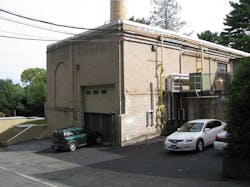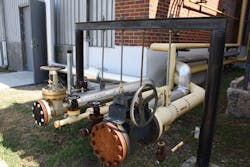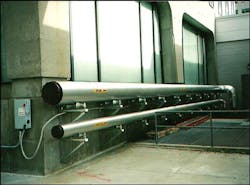Maximizing ‘Temporary’ Boiler Connections for Future Reliability
When the time to replace a boiler—be it because of new government regulations, facility upgrades, or an emergency situation—comes, a temporary boiler or auxiliary may be needed to support the existing steam load during construction. In such cases, despite the temporary boiler’s or auxiliary’s interim status, all mechanical and electrical services, including fuel, feedwater, and steam, have to be provided according to their respective codes. Forward-thinking building owners see the connections not as a nuisance, but as reliable hard points enabling fluid installation of temporary boilers and auxiliaries.
This article discusses best practices for evaluating temporary-boiler and auxiliary sizing, optimizing the nature of connections for reliability, and determining layup and service termination points.
Overall Capacity
Initially, the inclination may be to size a temporary boiler according to the maximum calculated steam load. While that level of redundancy is ideal, it often is not feasible because of space concerns or cost. In such cases, consider sizing a temporary connection to accommodate the load required for minimum operation. The load profile of at least a year’s worth of data, based on metered fuel or steam use, will provide a good baseline for equipment sizing. From this data, facility personnel can determine services that could be reduced or eliminated in an emergency. Subtracting these services from the maximum load will reveal the load temporary boilers need to support.
Boilers Only or Boilers and Auxiliaries?
Rental boilers are available in capacities up to approximately 110,000 lb per hour (pph), while rental auxiliary trailers—which can come complete with pre-piped and pre-wired water softeners, deaerator, and feedwater pumps—are available in capacities up to 165,000 pph at 100-percent city-water makeup.
The nature of rental equipment and associated piping should be determined by the needs of the project. If a project includes rental auxiliaries, there may be a push to eliminate some services, such as feedwater and softwater. “Why pay to pipe those services when they are included with rental auxiliaries?” may be the thinking. If the end goal is long-term reliability, however, there is no better time to add feedwater and softwater connections. When an emergency arises, rental boiler auxiliaries may not be available because of a lack of inventory or greater need elsewhere. In such cases, permanent auxiliaries may have to suffice.
If a boiler plant, including all auxiliaries, has been compromised, rental auxiliaries may be called upon to backfeed the main plant. This arrangement gives the owner options for renting auxiliaries exclusively, which allows permanent auxiliaries to be taken down for maintenance or repair and the plant to get back online as quickly as possible.
Likely causes of the complete shutdown of a plant include flooding, widespread power outages, and fire, all of which can damage auxiliaries. The best enablers of the rapid deployment of boilers include multiple connections for auxiliaries.
Space
Boilers ship on a 53-ft lowboy semi-trailer, while auxiliaries are available in 53-ft box trailers with a maximum width of 12 ft. In both cases, 5 ft of clearance is required all around. Ideally, a space should be easily accessible from a road and allow trailers to be backed into place quickly.
Heads of facilities should make clear to campus users that spaces are dedicated for emergency use.
Water Connections
The most reliable long-term water arrangement includes provisions for city water, softwater, and feedwater fed from geographically distinct areas. Providing piping for just one of these services forces a plant to operate in a given configuration during an emergency.
City-water supply can be established at a local fire hydrant. When a fire hydrant is used as an emergency source of water for boilers, keep in mind:
- The hydrant must be available for use by the fire department. Although local requirements may vary, the user should provide a diverter valve allowing the fire department to connect for fire operations.
- Flow from the hydrant must be metered. Check with the water company for specific metering requirements.
- Temporary arrangements must include a water softener and deaerator. Have the meter, diverter valve, and hose with flanged connections ready for an emergency.
A temporary boiler should have dedicated hard softwater and feedwater connections from the permanent headers in the plant. If either permanent header is looped, softwater and feedwater should connect to both sides of the temporary-boiler header.
If the deaerator and feedwater pumps or softeners are functional, they can provide feedwater or softwater to the temporary facilities. Alternatively, rental auxiliaries, including deaerator and feedwater pumps or water softeners, could be used to backfeed the feedwater discharge header or softwater header. Availability of both services gives a plant maximum flexibility in an emergency.
Fuel Connections
Temporary boilers typically burn natural gas, with No. 2 fuel oil as backup. As with water, the fuels should come from separate locations within the facility. When possible, a gas connection should be used in the area of temporary boilers. Fuel-oil pumps likely will be located in the area of the primary boiler plant and could be damaged.
Instrument Air, Chemical Feed, and Blowdown
Instrument air, chemical feed, and blowdown are just as important to boiler operation as the other mechanical services mentioned, but tend to be overlooked. These services can be provided locally with small equipment; if they cannot be provided within 24 hr, hard piping of the services is recommended.
Electricity
Temporary boilers do not come with generators; therefore, sites are required to have power. Electrical service should be sized for the calculated boiler load and associated rental auxiliaries. As a general rule of thumb, 400 amps at 480 volts are required to generate 100,000 pph of steam. Manufacturers, however, should be consulted regarding electrical-service sizing. For electrical-connection purposes, a panelboard should be provided near temporary boilers.
The electrical feed for a temporary boiler should be separate from the main boiler-plant motor control center. This feed should be backed up by an emergency system on an automatic transfer switch.
Steam Connection
The steam pipe between a temporary boiler and main header should be designed, analyzed for thermal expansion, and routed according to the standards of a normal steam pipe. The steam connection is critical to ensuring that when temporary boilers and auxiliaries are needed, they can be put in place easily and made operative.
System Completion
Functionally, mechanical and electrical systems should be left in a state allowing rapid connection to temporary equipment. Mechanical services should be valved and flanged off. Electrical services should be taken back to the panelboard, with the panelboard serving as the future connection point. All services should be isolated and de-energized at their source.
For aesthetic purposes, connections can be enclosed in an architectural “dog house,” behind panels, or in a manhole with a hatch-style door.
Conclusion
Right now, while your facility is in normal operations, you have an opportunity to identify a location for temporary services and make a plan for connecting those services to the rest of the facility. Doing so will greatly increase the likelihood of your facility enduring an emergency.
Dave Ohler, PE, has been a mechanical engineer in RMF Engineering Inc.’s infrastructure department since 2007. He has worked on utility distribution projects, boiler-plant auxiliary replacements, and boiler replacements. He is a licensed first-grade operating engineer in the state of Maryland. He can be reached at [email protected].
Did you find this article useful? Send comments and suggestions to Executive Editor Scott Arnold at [email protected].



